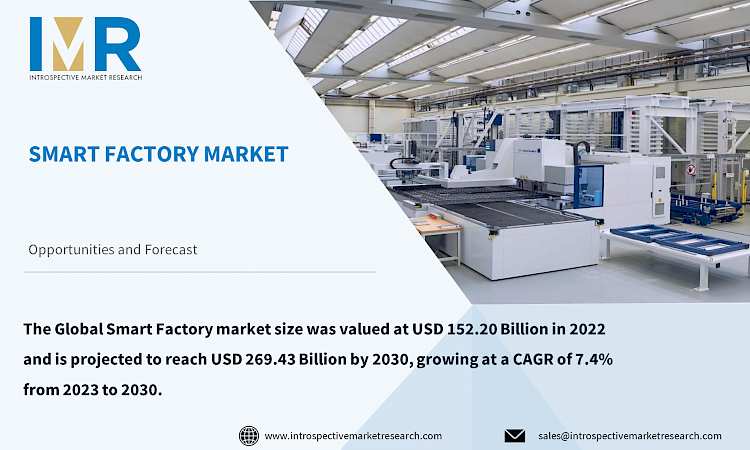
The Global Smart Factory market size was valued at USD 152.20 Billion in 2022 and is projected to reach USD 269.43 Billion by 2030, growing at a CAGR of 7.4% from 2023 to 2030.
A smart factory is a highly flexible and autonomous manufacturing system that leverages Industry 4.0 technologies to optimize performance, adapt to changing conditions, and learn from real-time experiences. This rapidly expanding market owes its growth to the increasing adoption of Industry 4.0 principles and the rise of automation and software-driven processes. Smart technologies have enabled real-time analysis and synchronization, resulting in cost savings and efficiency gains across the global market.
Technological advancements are the driving force behind the smart factory market, with innovations like machine learning, big data analytics, cloud computing, and artificial intelligence playing pivotal roles. Additionally, concepts such as Machine-to-Machine (M2M) communication and Wireless Sensor Networks (WSN), combined with the data generated by the Internet of Things (IoT), are propelling market expansion. The IoT encompasses data exchange between machines (M2M) and between machines and humans (M2P), and these interconnected technologies are poised to drive further growth in the smart factory sector.
Top Key Players for Smart Factory Market:
ABB, Robert Bosch GmbH, Siemens AG, Rockwell Automation, Inc., Schneider Electric, HP Development Company, L.P., Emerson Electric Co., General Electric, Honeywell International, Inc., Mitsubishi Electric Corporation and Other Major Players.
Market Dynamics and Factors for Smart Factory Market:
Drivers:
Automation in Smart Factories Boosts Productivity and Increases ROI
The implementation of smart factories brings about a transformative paradigm shift in manufacturing operations. One of its most significant advantages lies in its self-correcting and self-optimizing capabilities. Unlike traditional automation, a smart factory constantly analyzes vast amounts of data generated across its operations. A key driver of this efficiency is the reduction in downtime. Smart factories can predict and prevent issues that might otherwise lead to costly downtime, optimizing capacity utilization and minimizing production interruptions. Changeover times are also streamlined, as the system can adjust and adapt swiftly to different production requirements.
Opportunities:
Integration of wireless sensor networks (WSN) within smart factories
The integration of wireless sensor networks (WSN) within smart factories presents a significant opportunity for enhanced efficiency and cost reduction. WSNs enable real-time data monitoring and process control, improving the management of various parameters in plant operations. The reduced setup costs of WSNs, compared to wired alternatives, make them an attractive choice for industries such as oil and gas. As research and development in WSNs continue to expand, their active adoption in smart factories will broaden application areas and contribute to the advancement of automated systems.
Segmentation Analysis of the Smart Factory Market:
- By Type, the Smart Factory Market is currently dominated by Industrial Sensors, which enable predictive maintenance, reducing operational costs and downtime. Sensata Technologies' Sensata IQ platform exemplifies this trend, facilitating asset health monitoring and minimizing unscheduled downtime.
- By Deployment, the Cloud segment is set to lead the Smart Factory Market. The vast amount of data generated by IoT necessitates robust data storage solutions. Cloud platforms like AWS, Microsoft Azure, and Google Cloud provide manufacturers with the infrastructure and communication capabilities crucial for smart manufacturing.
- By End User Industry, Manufacturing takes the forefront in the Smart Factory Market. Smart factories enhance safety, efficiency, and reliability. For example, GE Healthcare increased its productive floor area by 66% during its smart plant transformation. Digital technology adoption in manufacturing is vital for staying competitive, meeting consumer demands, and optimizing the supply chain.
Regional Analysis of the Smart Factory Market:
The Smart Factory Market is presently led by the Asia-Pacific region, showcasing diverse manufacturing landscapes, from advanced countries like China, Japan, and South Korea to developing nations like India, Thailand, and Indonesia. China's ambitious "Made in China 2025" initiative, marked by significant government investment, underscores its commitment to smart manufacturing. In North America, robust growth is anticipated, driven by investments in innovative manufacturing technologies, particularly in aerospace, defense, automotive, and healthcare sectors, including notable 3D printing R&D endeavors by institutions like NASA.
Key Industry Development:
- In January 2023, Siemens Digital Industries Software and Deloitte unveiled the eXplore Live space at The Smart Factory @ Wichita, a cutting-edge experience center focused on Industry 4.0 innovation. Located at Wichita State University's Innovation Campus, this 3,000 square-foot facility will facilitate hands-on learning and innovation workshops, aiding companies in their digital transformation journey.
- In November 2021, the first digital application of its sort for a smart factory was released by ABB with the launch of ABB Ability Smart Melt Shop for the metals sector. With a six-month payback period, it is intended to increase melt shop production while saving energy and enhancing employee safety.




